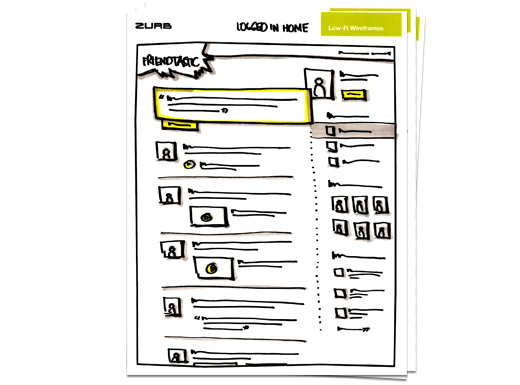Last week we talked about
the importance of getting feedback and
how it was applied when we built Verify. We want to go a little more in-depth and show you how we apply a sketch-based response tactic to client feedback.
Feedback: The Dreaded 8-Letter Word
For most people, feedback isn't the easiest thing to receive, even for clients. Their product is their foundation, and it's never fun to hear about cracks and weak spots in it. But when we think about designing for people, feedback is necessary to seal those areas and make the product stronger. That's why **we like to use sketching as the universal tool to help everyone see the problems and opportunities of their product together.** It lightens up the feedback process to make it more fun and productive.
Here are three examples of sketch-based responses we use while listening to clients.
Example 1: Opportunity Sketches
**Client Says:** "Our new product takes e-books to a whole new level. People can highlight passages, write notes, add resources, and let it sync with select friends. It's the new way to do book clubs and group studying!
**Our Response:** Opportunity sketches! We can take each feature and provide a series of opportunities from it, as well as develop new ideas that the client may not have thought of.

Example 2: Workflows
**Client Says:** "We continue to get support emails about adding a feature to upload a custom logo. Problem is, we already implemented it three months ago! Why aren't they finding it?"
**Our Response**: Sketch out a workflow and see if its current placement feels natural. From there, look for other places within the flow to introduce it.

Example 3: Low-Fi Wireframes
**Client Says:** "I'm liking a lot of opportunities that we've generated, in particular these four for our logged in home. Now all we have to do is fit it all on one page while keeping with some the existing elements."
**Our Response**: A few variations of the page using low-fi wireframes. This will help the client start to see everything coming together while still staying loose to allow for changes.

Keep the Feedback Loop Going
Sketching works in a variety of ways, but strategically using it to respond to clients is a great way to keep the dialogue flowing and to let your clients know you're listening. Sure feedback isn't always the icing on the cake, but when done visually with the aid of sketches, it produces a sugar high that gets people excited. And once they're loosened up, the dialogue can flow and great work can emerge.


